The 10 best weather places in the world
The 10 Best Weather Places in the World
by Antonio Garzón Beckmann
according to Thomas Whitmore (climatology researcher)
 Which are the best weather places in the world? This article reproduces the 10 cities with the best weather in the world, according to the classification of the study «Pleasant weather ratings» of the University of Syracuse (Consumer Travel Publications, 1996) which describes and rates the weather for 600 cities around the world. The author of the study is Thomas Peter Whitmore (1946-2012), who was director of climatology research of the University of Syracuse.
Which are the best weather places in the world? This article reproduces the 10 cities with the best weather in the world, according to the classification of the study «Pleasant weather ratings» of the University of Syracuse (Consumer Travel Publications, 1996) which describes and rates the weather for 600 cities around the world. The author of the study is Thomas Peter Whitmore (1946-2012), who was director of climatology research of the University of Syracuse.
Previous to the relation of the top 10 cities with the best weather in the world, here is a summary of the methodology applied in the study:
Methodology
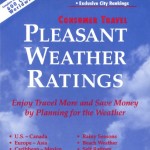 The 600 cities of this study are among the more popular for vacations, business travel or retirement with some other representative cities included.
The 600 cities of this study are among the more popular for vacations, business travel or retirement with some other representative cities included.
All weather information used in the study was derived from data collected over many years.
Pleasant Weather Ratings rates each half month period for pleasant weather and also provides a single, full-year rating score.
a) Half month ratings and weather descriptions
Each city has a weather profile divided into half month periods (days 1-15 and 16-31) with a symbol for each period, which defines the weather category and related temperatures. The 9 symbols used for the categories and their meanings are the following :
Pleasant weather:
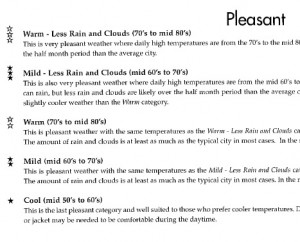 *** 3 white stars: Warm- less rain and clouds (70’s to mid 80’s ºF = 20’s ºC)
*** 3 white stars: Warm- less rain and clouds (70’s to mid 80’s ºF = 20’s ºC)
«This is a very pleasant weather where daily high temperatures are from 70’s to the mid 80’s (ºF). Although it can rain, there is usually less rain and clouds over the half month period than the average city.»
*** 3 black stars: Mild – less rain and clouds (mid 60’s to 70’s ºF = high 10’s to mid 20’s ºC)
«This is also very pleasant weather where daily high temperatures are from the mid 60’s to the 70’s (ºF). As in the category above, it can rain, but less rain and clouds are likely over the half month period than the average city. The Mild temperatures are very pleasant to people preferring sligthly cooler weather than the Warm category.»
** 2 white stars: Warm (70’s to mid 80’s ºF = 20’s ºC)
«This is pleasant weather with the same temperatures as the category Warm – less rain and clouds category. Daily high temperatures are from the 70’s to the mid 80’s (ºF). The amount of rain and clouds is at least as much as the typical city in most cases. In the more highly rated categories above there is less rain and clouds.»
** 2 black stars: Mild (mid 60’s to 70’s ºF = high 10’s to mid 20’s ºC)
«This is pleasant weather with the same temperatures as the category Mild- less rain and clouds category. Daily high temperatures are from the mid 60’s to the 70’s (ºF). The amount of rain and clouds is at least as much as the typical city in most cases. In the more highly rated categories above there is less rain and clouds.»
* 1 black star: Cool (mid 50’s to 60’sºF = 10’s to around 20 ºC)
«This is the last pleasant category and well suited to those who prefer cooler temperatures. Daily high temperatures are from the mid 50’s to the 60’s (ºF). A sweater or jacket may be needed to be comfortable during the daytime.»
Hotter weather:
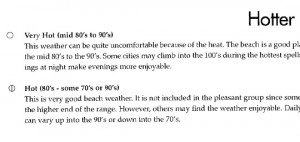 * The «cutted» full moon: Hot (80’s – some 70’s or 90’sºF = mid 20’s to low 30’s ºC)
* The «cutted» full moon: Hot (80’s – some 70’s or 90’sºF = mid 20’s to low 30’s ºC)
«This is very good beach weather. It is not included in the pleasant group since some people may be uncomfortable, at times, when temperatures vary up to the higher end of the range. However, others may find the weather enjoyable. Daily high temperatures should be in the 80’sºF (26,6ºC-31,6ºC), and sometimes high readings can vary up in the 90`sºF (32-37ºC) or down into the 70’sºF (21-26ºC).»
* The full moon: Very Hot (mid 80’s – 90’sºF = high 20’s to 30’s ºC)
«This weather can be quite uncomfortable because of the heat. The beach is a good place to be, but may be too hot for some. Daily high temperatures are from the mid 80’sºF (29ºC), to the 90’sºF (32-37ºC). Some cities may climb into the 100’sºF (over 37ºC) during the hottest spells. Care must be taken to avoid overexposure to the heat. The lower readings at night make evenings more enjoyable.»
Colder weather:
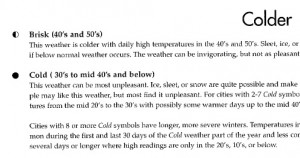 * The half new moon: Brisk (40’s and 50’s ºF = mid single digits to mid 10’s ºC)
* The half new moon: Brisk (40’s and 50’s ºF = mid single digits to mid 10’s ºC)
«This weather is colder with daily high tempeartures in the 40’s ºF (4-9 ºC) and 50’s ºF (10-15 ºC). Sleet, ice or snow are possible if temperatures are the lower end of the range or if below normal weather occurs. The weather can be invigorating, but not as pleasant as the more highly rated categories.»
* The new moon: Cold (30’s to mid 40’s ºF and below = single digits and below)
«This weather can be most unpleasant, Ice, sleet or snow are quite possible and make travel difficult and dangerous. Cold winds add to the chill. A few people may like this weather, but most find it unpleasant.»
In summary, the first two symbols (black and white three stars), represent the most pleasant weather conditions.
b) Full-year rating score
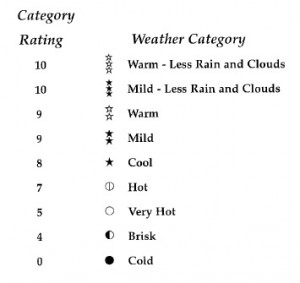 The full-year rating score evaluates the weather over a full year and is used for rating the 600 cities. It has a top score of 100. The calculation method is the following:
The full-year rating score evaluates the weather over a full year and is used for rating the 600 cities. It has a top score of 100. The calculation method is the following:
«Weather categories are rated 0-10 with 10 assigned to the most pleasant weather (see ratings on attached chart). The cities profiles show the weather twice each month (24 times a year). Each of the 24 boxes in the profile is assigned a category rating based on the weather category. For example, if January 1-15 is Brisk, that box receives a rating of 4. The ratings of the 24 boxes are then added together to reach one preliminary score for the year. The preliminary score is then divided by 2,4 putting the score on a scale of 0-100 and making the final full-year rating score.»
The top 10 (of the 600 cities)
So this are the top 10 cities with the best weather in the world, according to the study of Thomas Whitmore, in increasing order of importance:
10. San Luis Obispo (California, USA) / Rating Score=92
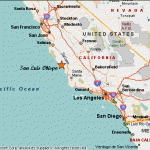 San Luis Obispo experiences a cool mediterranean climate with summers that are generally warm and sunny, often with morning fog from the Pacific coast. Winters are generally mild. Temperatures do, however, vary widely at any time of the year, with 80 °F (27 °C) readings in January and February not uncommon; storms of any kind are rare (wikipedia).
San Luis Obispo experiences a cool mediterranean climate with summers that are generally warm and sunny, often with morning fog from the Pacific coast. Winters are generally mild. Temperatures do, however, vary widely at any time of the year, with 80 °F (27 °C) readings in January and February not uncommon; storms of any kind are rare (wikipedia).
The attached chart shows the weather profile of San Luis Obispo, with 13 boxes (from 24) in the most pleasant weather category: 9 boxes correspond to the category «warm -less rain and clouds» (3-white stars) and 4 boxes to «mild – less rain and clouds» (3-black stars). From the total aggregation results the final score of 92.
9. San Miguel de Allende (Mexico) / Rating Score=92
 San Miguel is situated in the central mountains of Mexico at 6400 feet high, and because of this it has low humidity with sunny warm days and cool crisp nights. Winter temperatures are moderate with daily highs in the low to mid 70’s ºF (21-24 ºC) and nights in the 40’s ºF (4-9 ºC), while spring and summer temperatures average in the high 70’s to mid 80’s ºF for highs (26-29 ºC), and the mid 50’s ºF (13 ºC) for lows.
San Miguel is situated in the central mountains of Mexico at 6400 feet high, and because of this it has low humidity with sunny warm days and cool crisp nights. Winter temperatures are moderate with daily highs in the low to mid 70’s ºF (21-24 ºC) and nights in the 40’s ºF (4-9 ºC), while spring and summer temperatures average in the high 70’s to mid 80’s ºF for highs (26-29 ºC), and the mid 50’s ºF (13 ºC) for lows.
The attached chart shows the weather profile of San Miguel de Allende, with 13 boxes (from 24) in the most pleasant weather category: 5 boxes correspond to the category «warm -less rain and clouds» (3-white stars) and 8 boxes to «mild – less rain and clouds» (3-black stars). From the total aggregation results the final score of 92.
8. Mexico City (Mexico) / Rating Score=92
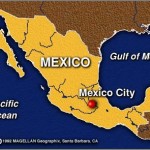 Mexico City has a subtropical highland climate, with pleasant summers and mild winters, and an annual average temperature of 64°F (18°C). Seasonal variations in temperature are small. The maximum temperatures of late spring and summer may reach up to 90°F (32°C). Mexico City has a high average annual rainfall, most falling in summer, the wettest month being July, and the driest month February. (worldtravels.com)
Mexico City has a subtropical highland climate, with pleasant summers and mild winters, and an annual average temperature of 64°F (18°C). Seasonal variations in temperature are small. The maximum temperatures of late spring and summer may reach up to 90°F (32°C). Mexico City has a high average annual rainfall, most falling in summer, the wettest month being July, and the driest month February. (worldtravels.com)
The attached chart shows the weather profile of Mexico City, with 8 boxes (from 24) in the most pleasant weather category: 3 boxes correspond to the category «warm -less rain and clouds» (3-white stars) and 5 boxes to «mild – less rain and clouds» (3-black stars). From the total aggregation results the final score of 92.
7. Los Angeles (California, USA) / Rating Score=93
 Los Angeles has a subtropical-mediterranean climate and receives just enough annual precipitation to avoid the «semi-arid climate» classification. Los Angeles has plenty of sunshine throughout the year, with an average of only 35 days with measurable precipitation annually. The average annual temperature in downtown is 66 °F (19 °C): 75 °F (24 °C) during the day and 57 °F (14 °C) at night. In the coldest month (January) the temperature typically ranges from 59 to 73 °F (15 to 23 °C) during the day and 45 to 55 °F (7 to 13 °C) at night. In the warmest month (August) the temperature typically ranges from 79 to 90 °F (26 to 32 °C) during the day and around 64 °F (18 °C) at night. (wikipedia)
Los Angeles has a subtropical-mediterranean climate and receives just enough annual precipitation to avoid the «semi-arid climate» classification. Los Angeles has plenty of sunshine throughout the year, with an average of only 35 days with measurable precipitation annually. The average annual temperature in downtown is 66 °F (19 °C): 75 °F (24 °C) during the day and 57 °F (14 °C) at night. In the coldest month (January) the temperature typically ranges from 59 to 73 °F (15 to 23 °C) during the day and 45 to 55 °F (7 to 13 °C) at night. In the warmest month (August) the temperature typically ranges from 79 to 90 °F (26 to 32 °C) during the day and around 64 °F (18 °C) at night. (wikipedia)
The attached chart shows the weather profile of Los Angeles, with 18 boxes (from 24) in the most pleasant weather category: 6 boxes correspond to the category «warm -less rain and clouds» (3-white stars) and 12 boxes to «mild – less rain and clouds» (3-black stars). The rest 6 boxes obtain the category «hot», due to the hot summer. From the total aggregation results the final score of 93.
6. Santa Barbara (California, USA) / Rating Score=93
 Santa Barbara experiences a warm-summer mediterranean climate characteristic of coastal California. Because the city lies along the ocean, onshore breezes moderate temperatures resulting in warmer winters and cooler summers compared with places farther inland. The attached chart shows the weather profile of Santa Barbara, with 13 boxes (from 24) in the most pleasant weather category: 8 boxes correspond to the category «warm -less rain and clouds» (3-white stars) and 5 boxes to «mild – less rain and clouds» (3-black stars). From the total aggregation results the final score of 93.
Santa Barbara experiences a warm-summer mediterranean climate characteristic of coastal California. Because the city lies along the ocean, onshore breezes moderate temperatures resulting in warmer winters and cooler summers compared with places farther inland. The attached chart shows the weather profile of Santa Barbara, with 13 boxes (from 24) in the most pleasant weather category: 8 boxes correspond to the category «warm -less rain and clouds» (3-white stars) and 5 boxes to «mild – less rain and clouds» (3-black stars). From the total aggregation results the final score of 93.
5. Oceanside (California, USA) / Rating Score=93
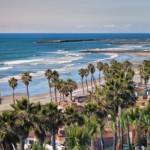 Oceanside experiences a semi-arid climate (Köppen climate classification). The average high temperatures range from 64 °F (18 °C) to 77 °F (23 °C). The average low temperatures range from 45 °F (7 °C) to 64 °F (18 °C). The attached chart shows the weather profile of Oceanside, with 16 boxes (from 24) in the most pleasant weather category: 7 boxes correspond to the category «warm -less rain and clouds» (3-white stars) and 9 boxes to «mild – less rain and clouds» (3-black stars). From the total aggregation results the final score of 93.
Oceanside experiences a semi-arid climate (Köppen climate classification). The average high temperatures range from 64 °F (18 °C) to 77 °F (23 °C). The average low temperatures range from 45 °F (7 °C) to 64 °F (18 °C). The attached chart shows the weather profile of Oceanside, with 16 boxes (from 24) in the most pleasant weather category: 7 boxes correspond to the category «warm -less rain and clouds» (3-white stars) and 9 boxes to «mild – less rain and clouds» (3-black stars). From the total aggregation results the final score of 93.
4. Port Elisabeth (South Africa) / Rating Score=94
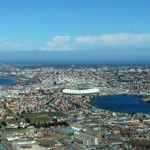 Port Elizabeth has a subtropical climate with light rain throughout the year. Under the Köppen climate classification, Port Elizabeth has an oceanic climate. The area lies between the winter rainfall, Mediterranean climate zones of the Western Cape and the summer rainfall regions of eastern South Africa. Winters are cool but mild and summers are warm but considerably less humid and hot than more northerly parts of South Africa’s east coast (wikipedia). The attached chart shows the weather profile of Port Elisabeth, with 9 boxes (from 24) in the most pleasant weather category: the 9 boxes correspond to «mild – less rain and clouds» (3-black stars). From the total aggregation results the final score of 94.
Port Elizabeth has a subtropical climate with light rain throughout the year. Under the Köppen climate classification, Port Elizabeth has an oceanic climate. The area lies between the winter rainfall, Mediterranean climate zones of the Western Cape and the summer rainfall regions of eastern South Africa. Winters are cool but mild and summers are warm but considerably less humid and hot than more northerly parts of South Africa’s east coast (wikipedia). The attached chart shows the weather profile of Port Elisabeth, with 9 boxes (from 24) in the most pleasant weather category: the 9 boxes correspond to «mild – less rain and clouds» (3-black stars). From the total aggregation results the final score of 94.
3. Casablanca (Morocco) / Rating Score=94
 The city Casablanca has a very mild mediterranean climate. Casablanca’s climate is strongly influenced by the cool currents of the Atlantic Ocean which tends to moderate temperature swings and produce a remarkably mild climate with little seasonal temperature variation and a lack of extreme heat and cold. In the coldest month (January) the average high temperature is 17,1 °C (62,8 °F), with an average low of 8,4 ºC (47,1 ºF). In the warmest month (August) the average high temperature is 26,3 ºC (79,3 °F), with an average low of 20,1 °C (68,2 °F). (wikipedia)
The city Casablanca has a very mild mediterranean climate. Casablanca’s climate is strongly influenced by the cool currents of the Atlantic Ocean which tends to moderate temperature swings and produce a remarkably mild climate with little seasonal temperature variation and a lack of extreme heat and cold. In the coldest month (January) the average high temperature is 17,1 °C (62,8 °F), with an average low of 8,4 ºC (47,1 ºF). In the warmest month (August) the average high temperature is 26,3 ºC (79,3 °F), with an average low of 20,1 °C (68,2 °F). (wikipedia)
The attached chart shows the weather profile of Casablanca, with 17 boxes (from 24) in the most pleasant weather category: 10 boxes correspond to the category «warm -less rain and clouds» (3-white stars) and 7 boxes to «mild – less rain and clouds» (3-black stars). The rest 7 boxes obtain the category «cool», due to the cooler temperatures of the winter. From the total aggregation results the final score of 94.
2. San Diego (California, USA) / Rating Score=95
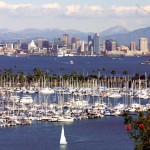 Under the Köppen-Geiger climate classification system, the San Diego area has been variously categorized as having either a semi-arid climate or a mediterranean climate. San Diego’s climate is characterized by warm, dry summers and mild winters with most of the annual precipitation falling between December and March. The city has a mild climate year-round, with an average of 201 days above 70 °F (21 °C) and low rainfall. (wikipedia)
Under the Köppen-Geiger climate classification system, the San Diego area has been variously categorized as having either a semi-arid climate or a mediterranean climate. San Diego’s climate is characterized by warm, dry summers and mild winters with most of the annual precipitation falling between December and March. The city has a mild climate year-round, with an average of 201 days above 70 °F (21 °C) and low rainfall. (wikipedia)
The attached chart shows the weather profile of San Diego, with 18 boxes (from 24) in the most pleasant weather category: 7 boxes correspond to the category «warm -less rain and clouds» (3-white stars) and 11 boxes to «mild – less rain and clouds» (3-black stars). As Casablanca, the rest 6 boxes obtain the category «cool», due to the cooler temperatures from december to march. From the total aggregation results the final score of 95.
1. Las Palmas de Gran Canaria (Canary Islands, Spain) / Rating Score=100
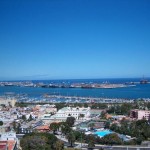 Las Palmas has a subtropical-desert climate with warm dry summers and moderately warm winters. Its average annual temperature is 20 °C (68 °F)–23 °C (73 °F) during the day and 17 °C (63 °F) at night. In the coldest month (January) the temperature typically ranges from 18 to 23 °C (64 to 73 °F) during the day (and sometimes more), around 15 °C (59 °F) at night. In the warmest months (August and September) the temperature typically ranges from 25 to 29 °C (77 to 84 °F) during the day, above 20 °C (68 °F) at night. Large fluctuations in temperature are rare. (wikipedia)
Las Palmas has a subtropical-desert climate with warm dry summers and moderately warm winters. Its average annual temperature is 20 °C (68 °F)–23 °C (73 °F) during the day and 17 °C (63 °F) at night. In the coldest month (January) the temperature typically ranges from 18 to 23 °C (64 to 73 °F) during the day (and sometimes more), around 15 °C (59 °F) at night. In the warmest months (August and September) the temperature typically ranges from 25 to 29 °C (77 to 84 °F) during the day, above 20 °C (68 °F) at night. Large fluctuations in temperature are rare. (wikipedia)
The attached chart shows the weather profile of Las Palmas, with 24 boxes (from 24) in the most pleasant weather category: 12 boxes correspond to the category «warm -less rain and clouds» (3-white stars) and 12 boxes to «mild – less rain and clouds» (3-black stars), what results in an aggregated score of 100. Las Palmas de Gran Canaria is the only city who achieves the highest possible score and has, according to this classification, the most pleasant weather of the world.
——————–
Link to the study of the University of Syracuse:
«Pleasant weather ratings», Thomas Peter Whitmore, Consumer Travel, University of Syracuse, 1996.



 12. May, 2014
12. May, 2014 











 Antonio Garzón Beckmann
Antonio Garzón Beckmann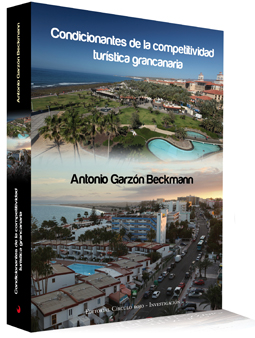





2 Responses to “The 10 best weather places in the world”